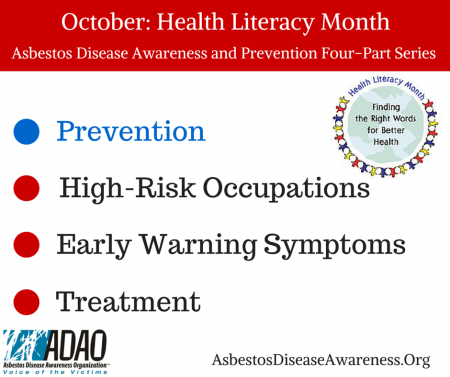Posted on October 7, 2019

October 7th – Part One: Prevent Asbestos Exposure
October 14th – Part Two: Recognize High Risk Occupations
October 21st – Part Three: Understand the Early Warning Symptoms for Asbestos-Caused Diseases
October 28th – Part Four: Finding a Center of Excellence for Treatment
October is Health Literacy Month and at the Asbestos Disease Awareness Organization (ADAO), that means driving our prevention initiatives with an even stronger force.. Everyone should know the Irrefutable Facts about how to protect your loved ones from asbestos exposure, because until researchers find a cure, the only way to stop asbestos-caused diseases is to prevent asbestos exposure.
Asbestos was widely used in building materials from the 1950s to the 1980s and still poses a significant threat, especially for those living in older homes. ADAO recommends increased awareness when refurbishing or repairing homes, schools, and buildings built before 2000, as materials could contain asbestos. If you suspect that your home or workplace has asbestos-containing materials, do not continue with any DIY projects or attempt to remove the asbestos on your own. Visit the Environmental Protection Agency’s (EPA) asbestos webpage to learn how to hire a professional to safely and legally remove asbestos.
This week, we will highlight asbestos exposure prevention in the home, school, and workplace. Please, take a few moments to read and share the important facts below.
- Always remember that asbestos is a known carcinogen that has not been banned in the US.
- Understand where asbestos might be in your home, school, and workplace.
- Review the EPA’s “Asbestos Dos and Don’ts” for the Homeowner
- Never test, remove or even sweep up asbestos yourself! Contact your EPA regional office for a list of licensed asbestos professionals in your area.
- Watch and share ADAO Prevention Board Co-Chair Brent Kynoch’s informative presentation “Preventing Asbestos Exposure in Your Home, Workplace and Beyond,” included at the bottom of this blog.
If you have any reason for concern, visit www.epa.gov/asbestos/ for more information, call the EPA’s Asbestos Ombudsman at 800-368-5888, or contact the Environmental Information Association (EIA), a multidisciplinary non-profit association, for testing and abatement inquires.
The EIA published their revision to the EPA’s 1985 document “Guidance for Controlling Asbestos-Containing Materials in Buildings” (EPA 560/5-85-024), affectionately known as the “Purple Book” because of the color of its cover. Get your copy today at www.eia-usa.org.
For more information about asbestos exposure at home, download our one-page flyer: “Identifying Asbestos in Your Home.”
As we say at ADAO, “Hear Asbestos. Think Prevention.”
Linda Reinstein
